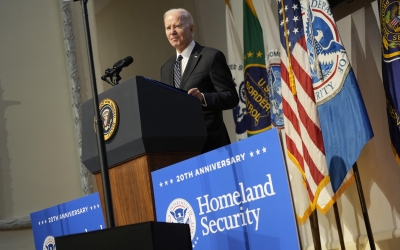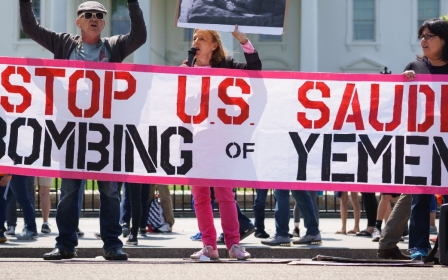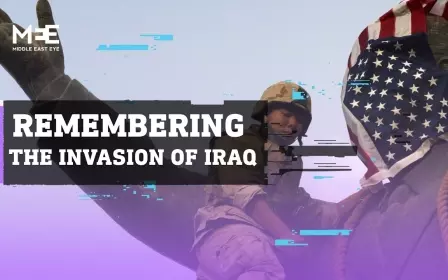Iraq war: How US campuses became militarised and forgot the war on terror

The US invasion of Iraq in 2003 made several things about the American political system abundantly clear.
First, there was a remarkable consensus between the two political parties. While Americans, eager to individualise the follies of empire, typically blame George W Bush for the devastation visited upon Iraq, it was Democrat Joe Biden who, as then head of the Senate Foreign Relations Committee, agitated for the invasion and Democrat Nancy Pelosi as House Speaker who refused to bring articles of impeachment against Bush for falsifying reasons for the invasion.
The invasion exposed the culture of repression that defines wartime in the US
It was also Democratic President Bill Clinton who, before Bush, had enforced genocidal sanctions on Iraq that led to the deaths of countless children.
The invasion also exposed the culture of repression that defines wartime in the US. The American media was banned from showing images of fallen soldiers’ flag-draped coffins returning from war, effectively downplaying the losses suffered during the insurgency.
New MEE newsletter: Jerusalem Dispatch
Sign up to get the latest insights and analysis on Israel-Palestine, alongside Turkey Unpacked and other MEE newsletters
Today, two decades have passed. Where I was then a college student and one of the countless anti-war demonstrators, I am now at the head of the classroom, teaching courses about race, empire, and the war on terror.
What’s remarkable to me as an educator is the undeniable campus legacy of the Iraq war.
On the one hand, the campus is undeniably militarised, awash in defence dollars and intelligence funding, ensuring the production of students and research agendas that shore up the global ambitions of US statecraft.
And, on the other, we have a student body that is, perhaps by design, armed with very little in the way of historical context about US involvement in Iraq or the war on terror itself.
Militarised schooling
American public schools, increasingly cash-strapped (especially in working-class neighbourhoods of colour), "solve" their budgetary problems by partnering with companies like Raytheon or Lockheed Martin.
Nicole Nguyen calls the resulting climate a "curriculum of fear", in which schoolchildren learn about parabolas through hypothetical math problems about North Korean missiles and take classes called "Foundations of Homeland Security".
Those who go on to college arrive in a higher education setting that is best labelled as a "military academic industrial complex".
As Henry A Giroux writes: "In a post-9/11 world in which the war on terrorism has exacerbated a domestic culture of fear and abetted the gradual erosion of civil liberties, the idea of the university as a site of critical dialogue and debate, public service, and socially responsible research appears to have been usurped by a patriotic jingoism and a market-driven fundamentalism."
Universities and colleges throughout the US embody the expansive militarism that shapes all aspects of American life. War-making has been embedded across academia such that labs and research programmes receive generous support from the military and university administrators who vie for defence dollars.
Often these administrators themselves come from careers in defence or national security, suggesting that there exists a veritable revolving door between militarism and academia. In many ways, universities themselves are war profiteers.
The proliferation of new degree programs reflects this increased militarism. Degrees and certificates related to homeland security or counterterrorism arm students with a "security mindset" – the notion that the ever-expanding apparatus of militarism is something that keeps us safe.
To be clear, a student can complete a degree related to homeland security or counterterrorism without encountering a mere mention of Operation Cyclone, the CIA program to fund and arm right-wing Islamists in Afghanistan, or the 38 million people who have been made refugees as a result of the war on terror.
These programs don’t teach about the persistent protests around the world against the construction of US military bases, nor of the fact that indigenous environmentalists in the US have been labelled terrorists.
This reality is met by very little in the way of resistance or outcry, neither from liberals nor conservatives.
#NeverRemember
American students arrive at universities after spending years in an education system that has vacated itself of historical context. School lessons rarely delve into the decades of US involvement in Iraq, the operations of the war on terror, or the Cold War politics that led directly to the attacks of 9/11.
A collective forgetfulness, a veritable national amnesia, looms large in the American understanding of the 2003 invasion of Iraq.
In my own research, I ask young Americans – those too young to remember the early days of the War on Terror – why Iraq was invaded in 2003. Many indicate that it was in response to terrorist attacks against the US under Saddam Hussein.
In fact, a striking one in five of my respondents believed that Saddam Hussein was behind the 9/11 attacks. It seems that in the American public consciousness, Iraq has been indelibly linked with 9/11, a connection forged at the time that persists to this day.
Rarely are students familiar with the falsehoods delivered by then Secretary of State Colin Powell at the United Nations in 2003, nor about the massacre by Blackwater at Nisour Square.
In my classroom, students who learn that Blackwater’s Erik Prince went on, fully absolved, to play a key role in Trump’s presidency are absolutely floored. I can’t help but wonder how their political consciousness might have looked different had they learned this sooner.
Abu Ghraib, the most obvious manifestation of the brutality of the US invasion, is all but wiped clean from the American collective consciousness
Perhaps the most pivotal erasure of the Iraq war is that of the Abu Ghraib revelations. The photographs of the systemic abuses are images that, were we to have an appropriate and balanced national memory, would be required material in any American history class.
Yet, this most obvious manifestation of the brutality of the US invasion, captured in spectacular photos, is all but wiped clean from the American collective consciousness.
I’ve written about the key role forgetfulness plays in the US war on terror. While the events of 9/11 are branded with the slogan "never forget", it is true that Americans have all but forgotten the realities of the attacks, including what came before and what followed.
The US classroom, both at the university level and K-12 is perhaps the most revealing site of this amnesia.
Systemic ignorance
We must put these two realities – the militarisation of education and the vast lack of awareness about America’s militarism – alongside one another.
Systemic ignorance and militarism have become strange bedfellows, enshrined into the very structures of higher education.
I’m reminded of Colin Powell’s pivotal 2003 speech at the UN in which he presented known falsehoods about Saddam Hussein’s access to dangerous biological weapons, pushing the global community towards war.
While many remember the speech – Powell waving around a small vial - demonstrating the small number of munitions Saddam would need to visit mass devastation in the world – what came before it is what's often forgotten.
Behind Powell was a replica of Picasso’s Guernica, a painting depicting the grotesque realities of war.
Before taking the podium, Powell had asked that the painting be shrouded.
Perhaps nothing is more fitting an allegory for American militarism than a shroud to mask the depiction of the kind of suffering that would result from the Iraq war, the greatest crime of our century.
The views expressed in this article belong to the author and do not necessarily reflect the editorial policy of Middle East Eye.
This article is available in French on Middle East Eye French edition.
Middle East Eye delivers independent and unrivalled coverage and analysis of the Middle East, North Africa and beyond. To learn more about republishing this content and the associated fees, please fill out this form. More about MEE can be found here.






